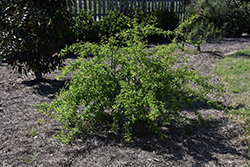Fri & Sat 8am - 8pm
Sun 8am - 7pm
Anytown, USA 12345
fax: 261.787.0463
e-mail: info@successgc.com


Plant Finder

Height: 15 feet
Spread: 15 feet
Sunlight:
![]()
Hardiness Zone: 6a
Other Names: Cherokee Plum, Florida Sand Plum, Sandhill Plum
Description:
This native plum-bearing variety grows in an upright, irregular way with reddish branches and near-black bark; small white flowers emerge before the leaves in late winter to spring followed by red plums that ripen in late summer; a great landscape accent
Ornamental Features
Chickasaw Plum is smothered in stunning clusters of fragrant white flowers along the branches from late winter to early spring before the leaves. The fruits are showy red drupes with a chartreuse blush and which fade to dark red over time, which are carried in abundance from early summer to late fall. The fruit can be messy if allowed to drop on the lawn or walkways, and may require occasional clean-up. It has forest green deciduous foliage. The small pointy leaves turn yellow in fall. The rough black bark is extremely showy and adds significant winter interest.
This plant is primarily grown as an ornamental, but it's also valued for its edible qualities. The round tart fruit is most often used in the following ways:
- Fresh Eating
- Cooking
- Baking
- Preserves
Landscape Attributes
Chickasaw Plum is a multi-stemmed deciduous shrub with an upright spreading habit of growth. Its average texture blends into the landscape, but can be balanced by one or two finer or coarser trees or shrubs for an effective composition.
This shrub will require occasional maintenance and upkeep, and is best pruned in late winter once the threat of extreme cold has passed. It is a good choice for attracting birds, bees and butterflies to your yard. Gardeners should be aware of the following characteristic(s) that may warrant special consideration;
- Messy
- Suckering
- Disease
- Spiny
Chickasaw Plum is recommended for the following landscape applications;
- Accent
- Hedges/Screening
- General Garden Use
- Naturalizing And Woodland Gardens
- Orchard/Edible Landscaping
Planting & Growing
Chickasaw Plum will grow to be about 15 feet tall at maturity, with a spread of 15 feet. It has a low canopy with a typical clearance of 1 foot from the ground, and is suitable for planting under power lines. It grows at a medium rate, and under ideal conditions can be expected to live for 40 years or more. This variety requires a different selection of the same species growing nearby in order to set fruit.
This shrub should only be grown in full sunlight. It is very adaptable to both dry and moist growing conditions, but will not tolerate any standing water. It is not particular as to soil pH, but grows best in sandy soils. It is highly tolerant of urban pollution and will even thrive in inner city environments. This species is native to parts of North America.
